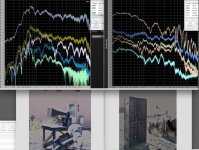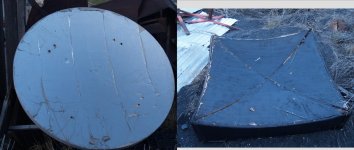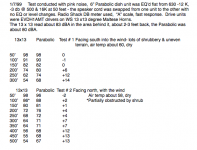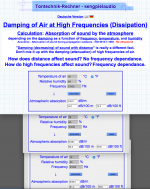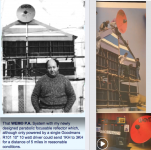Re-entrant PA horns suffer enough from this - think “nasal sound” on steroids. And they’re directive, but not THAT directive or you would just use one.
….. but maybe they would makwe a nice "feeder" for a parabolic reflector.
Regards
Charles
Art mentioned once his Malthese horns to create a spooky sound from nowhere. Maybe that is an alternative?
Re-entrant PA horns suffer enough from this - think “nasal sound” on steroids.
thats a very absolute statement, what reentrant horns have you heard?
I've heard the danley SH95s and they where extremely neutral and even
Re-entrant horn is this: http://www.atlasied.com/c/thumbs/00...dspeaker-with-25v707v-30w-transformer_500.png
SH95 is a multiple entry horn.
SH95 is a multiple entry horn.
That would only work for a very small point in space. WL/2 at 1KHz is only 170mm..
That depends on how close the sources are to each other. Put em all at the same place, it's a point source with wide coverage area. Put them in a dish shaped pattern pointing in one direction, it will cover less area with more 'gain', same as a concave reflector. Put them in a line arranged successively away from each other and delayed properly, it's the reverse of a shotgun mic, will work about anywhere along the direction of that line.
I have specifically used a Maltese horn for "spooky" Halloween effects, the narrow 13x13 degree dispersion can give the impression of a whisper being right behind the "victim" though the source is 20 meters away, hidden beneath a bush...Art mentioned once his Malthese horns to create a spooky sound from nowhere. Maybe that is an alternative?
That said, though directional, the narrow conical expansion horn, like any typical point source, drops at 6 dB per doubling in distance. Parabolic, or hyperbolic projectors can reduce the theoretical fall off rate to half that.
I have tested the Maltese horn with a 6 foot diameter parabolic dish, (and a plywood 45" x 45" version) it resulted in about 6 dB less inverse distance loss compared to the horn only.
In post #14, I provided a link describing the Hyperboline, it shows a comparison between it and a Maltese horn taken under the same (bad) conditions. The Hyperboline had about 10dB less attenuation over a distance of 128 meters compared to the Maltese horn.
To put that in perspective, a parabolic or hyperbolic reflector/projector could sound less than half as loud at the source (Focused4Door's roof) to achieve the same level at a very long distance.
One of the "very interesting" effects using such a narrow, low distance loss device is while standing along side it, its echo from a distant building can sound louder than the source!
Art
Attachments
That depends on how close the sources are to each other. Put em all at the same place, it's a point source with wide coverage area. Put them in a dish shaped pattern pointing in one direction, it will cover less area with more 'gain', same as a concave reflector. Put them in a line arranged successively away from each other and delayed properly, it's the reverse of a shotgun mic, will work about anywhere along the direction of that line.
So basically array the speakers with wide spacing, like a Very Large Array radio telescope with large spaces in-between?
Re-entrant horn is this: http://www.atlasied.com/c/thumbs/00...dspeaker-with-25v707v-30w-transformer_500.png
SH95 is a multiple entry horn.
haa of course, my bad. definatly sound awefule haha. probably would work though!
Thinking that this is because the reflection points are in shadow.the narrow 13x13 degree dispersion can give the impression of a whisper being right behind the "victim"
The angle for the chosen horn should avoid sending sound to the halfway points. It should also be near to square or round for simplicity.
The VLA uses Very-long-baseline interferometry. In VLBI a signal from an astronomical radio source, is collected at multiple points, the distance between the time difference between the arrivals of the radio signal at different telescopes allows observations of an object that are made simultaneously by many radio telescopes to be combined, emulating a telescope with a size equal to the maximum separation between the telescopes.So basically array the speakers with wide spacing, like a Very Large Array radio telescope with large spaces in-between?
While that concept in theory could be applied to sound, both of Bwaslo's ideas are flawed in practicality:
" Put them in a dish shaped pattern pointing in one direction, it will cover less area with more 'gain', same as a concave reflector."
There would be more "gain" at the focal point, but the spacing between the points makes any atmospheric differences (wind, temperature gradients, etc.) more problematic than a single point source.
"Put them in a line arranged successively away from each other and delayed properly, it's the reverse of a shotgun mic, will work about anywhere along the direction of that line."
Although that type of "end fire" array works for reducing rear noise with low frequency sound that will diffract around the points (individual loudspeakers) in the line, the reflections off the backs of each speaker in the line would scatter, making the sources quite easily identifiable, and reducing forward gain compared to a line array.
In either of the above cases, the inverse distance law of 6dB loss per doubling of distance would prevail, and require far more complexity while being an order of magnitude less effective than using a large parabolic reflector dish with a single point source, which creates an effective plane wave.
The attached test from 1/7/1999, though very basic, shows real world results- the very narrow 13 x13 degree horn at about 122 dB at one meter (98 dB at 50') dropped into the wind noise floor at 300 feet (into the wind) and 400 feet (with the wind). Using the parabolic dish, the sound level remained more than 12dB above the wind noise at 300 feet (into the wind) and 500 feet (with the wind).
Later that month, used the parabolic device (a 45" x 45"plywood version) for PA announcements in a 50' x 300' long tent during the 1999 Alpine Ski World Championships held in Vail Colorado.
The announcements could be heard above the ambient crowd noise at the tent entrance, about 240' distant, while patrons waiting in a line that stretched that distance waiting for commemorative pins could still easily converse only 10' from the device, which was only sitting about four feet off the floor, directed up for "bounce" off the tent ceiling at about the half-way point.
Funny event, provided PA for comedians, puppet shows, and bands, there was probably no more than 50 people there ever, until the pin giveaway, when 500 people would line up, then leave...
Art
Attachments
Last edited:
The hackaday project could be risky. The carrier wave is an ultrasonic signal directed at the listener. Just because no one hears it does not mean that it doesnt matter.
I have a commercial version of that hackaday design - it works kind of well within limits and is creepy to experience. The important part about how it works is this:
With this device, though, the air itself acts in a nonlinear way and demodulates the signal, producing the modulated signal as audible sounds.
I purchased mine from ebay for £1 (£11 with shipping) and have missed others for similar tiny prices.. They are used in exhibitions etc so that a visitor can hear the audio by standing in a certain spot, or the sound is reflected off a display so the demodulation happens from the reflection and so the sound appears to come from the display.
Frequency response is kind of limited to speech .
Although these ultrasonic devices definitely exhibit very narrow dispersion, the high frequencies used are quickly absorbed by air, rendering their effective range rather short.I have a commercial version of that hackaday design - it works kind of well within limits and is creepy to experience.
Frequency response is kind of limited to speech .
The OP, Focused4Door is looking for projection of around 450 feet.
Using this calculator:
Calculation method of absorption of sound by atmosphere air damping dissipation absorbtion high frequencies attenuation sound during propagation outdoors outdoor - sengpielaudio Sengpiel Berlin
We see if a 21kHz carrier wave is used, in addition to the normal inverse distance losses (50+dB) , an additional 55 to 88 dB loss (humidity and temperature dependent) would be incurred compared to normal speech range, putting the output level at that distance below audibility over any ambient noise.
Art
Attachments
Last edited:
Parabolic Reflector from 50 Years ago
Later this month will be the 50 year anniversary of the 1970 Isle of Wight festival where Charlie Watkins first used his parabolic speaker reflector.
5 mile projection using a 10 watt 10" speaker "in reasonable conditions" !
Art
Later this month will be the 50 year anniversary of the 1970 Isle of Wight festival where Charlie Watkins first used his parabolic speaker reflector.
5 mile projection using a 10 watt 10" speaker "in reasonable conditions" !
Art
Attachments
CARRETA TREME TREME UMA IGNORÂNCIA DE SOM - YouTube
Theres also visible sound directivity.
Wonder how narrow that power alley can be if theres couple dsp processors involved
Theres also visible sound directivity.
Wonder how narrow that power alley can be if theres couple dsp processors involved
Although these ultrasonic devices definitely exhibit very narrow dispersion, the high frequencies used are quickly absorbed by air, rendering their effective range rather short.
The OP, Focused4Door is looking for projection of around 450 feet.
Using this calculator:
Calculation method of absorption of sound by atmosphere air damping dissipation absorbtion high frequencies attenuation sound during propagation outdoors outdoor - sengpielaudio Sengpiel Berlin
We see if a 21kHz carrier wave is used, in addition to the normal inverse distance losses (50+dB) , an additional 55 to 88 dB loss (humidity and temperature dependent) would be incurred compared to normal speech range, putting the output level at that distance below audibility over any ambient noise.
Art
Thanks - I couldn't quite picture 450 ft.. so I think I put it out of my mind.
Ah yes, that's about 137 metres! Pretty far... the ultrasonic things are good for about 20 indoors, still air.
After reading "Sound From Ultrasound:Ah yes, that's about 137 metres! Pretty far... the ultrasonic things are good for about 20 indoors, still air.
The Parametric Array as an Audible Sound Source" by F. Joseph Pompei, found the ultrasonic carrier wave frequency used in current units is generally upwards of 40-60kHz, which puts air attenuation at about 1-2 dB per meter, in addition to the inverse square law. The audible audio generated is 15-40dB down from the carrier, so around 130dB at 60kHz would be required for about 60dB of speech range at 20 meters, falling to virtually no audible output by 80 meters.
That said, having heard Pompei's Audio-spotlight 24i, I was very impressed with how well it works in the first 3 meters, though still don't like the idea of using 126dB of VHF to produce a conversational level output...
Art
- Home
- Loudspeakers
- Multi-Way
- extremely narrow directivity speaker design
